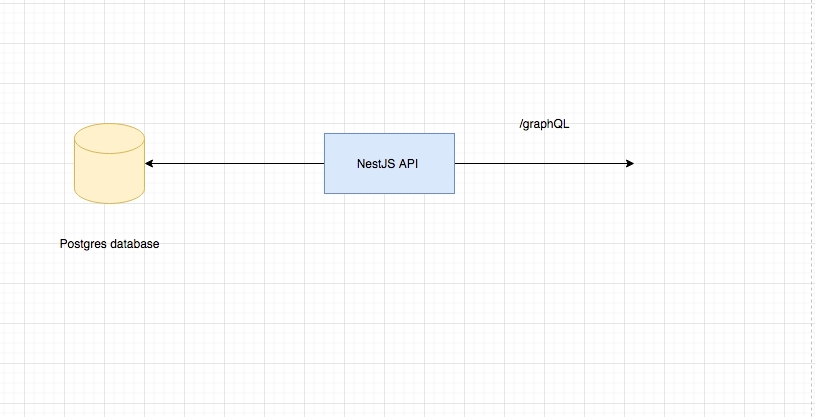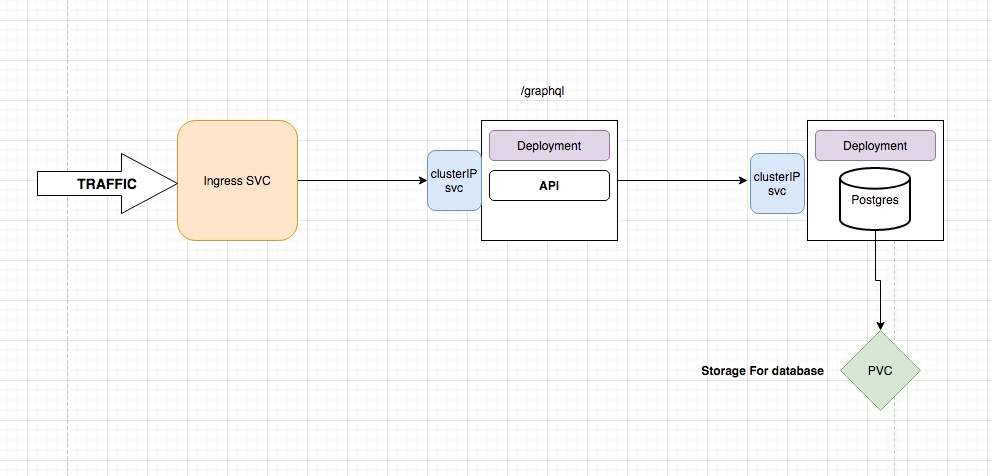- This graphql api is connected to Postgres database to retrieve data .
These instructions will get you a copy of the project up and running on your local machine for development and testing purposes. See deployment for notes on how to deploy the project on a live Kubernetes system.
You need to install the fellowing software in order to get the application up and running :
- Node.js and npm.
- NestJS.
- Postgres database.
- Docker.
- Kubernetes on cloud.
The application architecture contain 2 part
- Simple GraphQl API that connect to Postgres database with define tables using TypeORM as interface to retrieve information
- Download and Install node.js and NPM from https://nodejs.org/en/download/
-
Download or clone the project code from https://github.com/abdm64/nest-graph-ql
-
install NestJs Framework from the npm cli for more information please visit NestJS Web site
-
Install all required npm packages by running npm install from the command line in the api directory (where the package.json is located).
cd api
npm install
-
Before start the application you should change the keys in the api/src/config directory (host, user, password and db name ) in order to connect to the postgres database.
-
Start the application by running npm start from the command line in the api directory , you should see the message: "Nest application successfully started".
npm start
- Now you have graphQl api that connected to the database and you can make query ( please see the attached email ).
- In order to deploy this application in production we need :
- Docker to build image for this application and push it to the docker hub or private registry .
- Kubernetes cluster to run the application in production mode from the image that was created .
- Download and install docker on your machine Please Visit Docker
- Build your own docker image and push it to your repo by running "docker build -t my-app-name:v1 . " from the command line in api directory
cd api
docker build -t my-app-name:v1 .
you need to push the image to Docker hub or your own private registry .
- Run your Docker image for the application by the command line
docker run -e [inject your env variable here] my-app-name:v1
PS: you need to run the docker image and attached it to a running Postgres image
- Also you can run the application connected to a database as service by running with pg admin to manage the Postgres database at port 5050 you can change it in docker-compose file
docker-compose up
and the docker-compose.yaml handle all the task for you running the application with a database attached
- to drop the running container use the command
docker-compose down
-
Please fellow the instruction in the app-dep.yaml file in the k8s folder to update all information needed ( env var ) in order to the application work on Kubernetes cluster
-
create secret in the same namespace to store your pg password by running the Cammand
kubectl create secret generic <secret_name> --from-literal PGPASSWORD=<your password>
- To run the application on Kubernetes cluster just run the fellowing command
kubectl apply -f k8s
this will create the fellowing Kubernetes objects:
- Namespace a virtual cluster for all your resource related to this application ( pods services secret)
- Deployment for the application with one pod ( running container) insuring high availability for that service.
- Deployment for the Postgres database in one pod ( not the perfect solution for stateful application )
- PVC to store the data from the database
- Cluster ip service that connected to the pod .
- ingress service that connect the cluster ip service with ingress-nginx load balancer to expose it outside (Public) .
PS : you must install NGINX Ingress Controller on your k8s cluster before applying the final deployment please check this link https://kubernetes.github.io/ingress-nginx/deploy/ for more information.
- to drop the application just run the command :
kubectl delete -f k8s
this will delete all kubernetes objects
- NestJS - A progressive Node.js framework.
- Postgres - Open source relationel database.
- TypeORM - promise-based Node.js ORM for Postgres, MySQL, MariaDB, SQLite and Microsoft SQL Server.
- GraphQL query language for APIs.
- Docker - Software platform for building and packaging applications.
- Kubernetes - Container Orchestration.
Made with ❤️ by Abdellah

